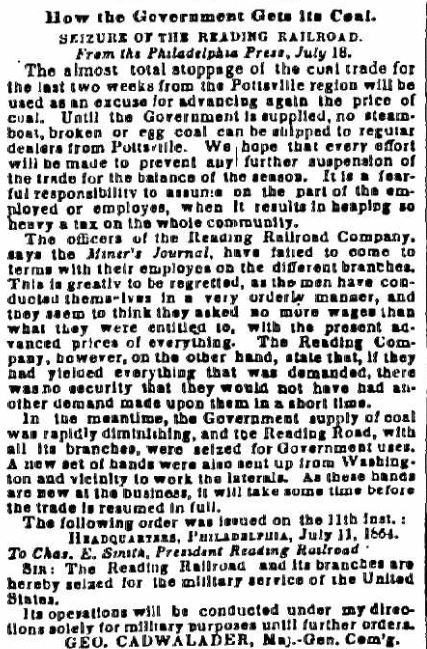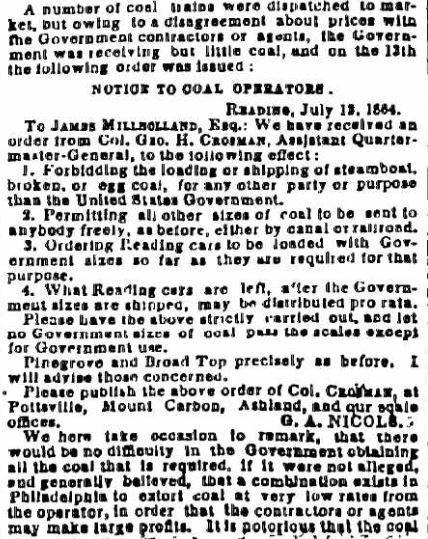The Great Shohola Train Wreck – Was the Coal Train in a Hurry?
Posted By Norman Gasbarro on May 30, 2014
On the same day that the New York Times reported on the Great Shohola Train Wreck, there appeared in that newspaper on the same page and just under the train wreck report, an article telling of the government seizure of the Reading Railroad and all its branches and of the almost total stoppage of the coal trade from the Pottsville, Schuylkill County, Pennsylvania, region – which had taken place for a period two weeks prior. The New York Times article does not go into too much detail as to the reasons for the coal-flow stoppage and railroad seizure – but it is mentioned that one of the issues was the wages paid to the men and another issue was the possible forcing up of the price of coal.
The coal train that switched onto the main Erie line on 15 July 1865 resulting in the collision with the prisoner train near Shohola, Pike County, Pennsylvania was said to be the result of the failure of the telegraph operator at Lackawaxen to notify the coal train that an “extra” (the prisoner train) was heading west on the same one-track line. That telegraph operator has been identified as Douglas “Duff” Kent, but as has been noted here on this blog, attempts to research this individual have been fruitless to date – leading to a suspicion that he may not have existed – or perhaps was a fake name given to protect someone else who switched the coal train onto the main line.
The New York and Erie Railroad had an interest in getting the fifty coal cars to the New York area as quickly as possible – due to the coal shortage that had been created as a result of the Reading Railroad problems. Whether this issue has ever been addressed in any analysis of the cause(s) of the train wreck, is not presently known.
Of the two engineers, the coal train engineer, Samuel Hoyt, was the only one who survived – and that was by jumping from the engine cab just before the impact. The fireman of the coal train was crushed to death in the collision impact and the fireman of the prisoner train died as well.
The questions that need to be asked concern whether Hoyt was ever told that there was another train expected on the one-track line at Lackawaxen or whether he knew that another train was expected and thought he could beat it to Shohola. Was he working on a tight schedule to get the coal train to its destination? If he knew the line between Lackawaxen and Shohola, he knew of only one blind curve on the route – the one at King and Fuller’s cut. If he could make it through the blind curve, the visibility was relatively good from there to Shohola and a warning could be sounded to any on-coming trains – with sufficient time for both to stop. Was Hoyt especially alert as he approached the blind curve – which allowed him to notice the on-coming prisoner train and gave him sufficient time to jump and save himself?
Additional research is needed on the coal issues. Additional research is also needed on the two engineers and two firemen who were in the engine cabs as the trains approached King and Fuller’s cut.
To see all the posts in this series, click on ShoholaTrainWreck.
The transcription of the New York Times article of 19 July 1864 appears below.
How the Government Gets Its Coal
SEIZURE OF THE READING RAILROAD
From the Philadelphia Press, 18 July 1864
The almost total stoppage of the coal trade for the last two weeks from the Pottsville region will be used as an excuse for advancing again the price of coal. Until the Government is supplied, no steamboat, broken, or egg coal can be shipped to regular dealers from Pottsvillle. We hope that every effort will be made to prevent any further suspension of the trade for the balance of the season. It is a fearful responsibility to assume on the part of the employed or employees, when it results in keeping so heavy a tax on the whole community.
The Officers of the Reading Railroad Company, says the Miners Journal, have failed to come to terms with their employees on the different branches. This is greatly to be regretted, as the men have conducted themselves in a very orderly manner, and they seem to think they asked no more wages than what they were entitled to, with the present advanced prices of everything. The Reading Company, however on the other hand, state that, if they had yielded everything that was demanded, there was no security that they would not have had another demand made upon them in a short time.
In the meantime, the Government supply of coal was rapidly diminishing, and the Reading Road, with all its branches, were seized for government uses. A new set of hand were also sent up from Washington and vicinity to work the laterals. As these hands are new at the business, it will take some time before the trade is resumed in full.
The following order was issued on the 11th inst.:
HEADQUARTERS, Philadelphia, 13 July 1864
To Charles E. Smith, President Reading Railroad
SIR: The Reading Railroad and its branches are hereby seized for the military service of the United States.
Its operations will be conducted under my direction for military purposes until further orders.
GEORGE CADWALADER, Major-General Commanding
——————–
A number of coal trains were dispatched to market, but owing to a disagreement about prices with the Government contractors or agents, the Government was receiving but little coal, and on the 13th the following order was issued:
NOTICE TO COAL OPERATORS.
Reading, 13 July 1864
To JAMES MILLHOLLAND, ESQ: We have received an order from Col. George H. Crosman, Assistant Quartermaster-General to the following effect:
1. Forbidding the loading or shipping of steamboat, broken, or egg coal, for any other party or purpose than the United States Government.
2. Permitting all other sizes of coal to anybody freely, as before, either by canal or railroad.
3. Ordering Reading cars to be be loaded with Government sizes so far as they are required for that purpose.
4. What Reading cars are left, after the Government sizes are shipped, may be distributed by pro rata.
Please have the above strictly carried out, and let no government sizes of coal pass the scales except for Government use.
Pinegrove and Broad Top precisely as before. I will advise those concerned.
Please publish the above order of Col. Crosman at Pottsville, Mount Carbon, Ashland and scale offices.
G. A. NICHOLS
We here take occasion to remark, that there would be no difficulty in the Government obtaining all the coal that is required, if it were not alleged, and generally believed, that a combination exists in Philadelphia to extort coal at very low rates from the operator, in order that the contractors or agents may make large profits. It is notorious that the coal operators have always been willing to sell their coal t the Government at much lower rates than to their regular customers, and we know that a large portion of our coal operators are willing to sell to the Government at from $1 to $1.50 per ton less, provided they were satisfied that the Government derived the advantage of the reduction, instead of the contractors or agents. We are assured that nearly the whole difficulty in obtaining coal arises from these causes.
——————————
News clippings are from the newspaper resources available from Ancestry.com.
 ;
;




I’m pleased I chanced upon this page, really glad to have read this, I’m interested in seeing what other people think on the topic.